This guide is designed as a reference to the Sony BRAVIA Workflow, used to calibrate Sony’s upper-end Android LCD, MiniLED, and OLED models with Calman.

![]()
The BRAVIA workflow is used to calibrate Sony’s upper-end Android LCD, MiniLED, and OLED models with Calman. This workflow will walk you through the process step-by-step, and pre-configures most needed Calman Settings.
The workflow options are pre-configured so once connected over DDC, you will simply have to click “AutoCal” button on each of the following pages (Luminance, Grayscale, and Colorspace) to calibrate.
- Calman Required Version
- Calman 2024 v5.15.7 or newer
- Required Hardware
- Calman Compatible Pattern Generator
- For information see Calman Compatible Pattern Generators
- An HDR-capable pattern generator is only required if HDR validation is required. See note below
- Calman Compatible Meter
- For information see Calman Compatible Meters
- Calman Compatible Sony TV
- Must be running Android 8.0 or higher to download Calman for Bravia
- Calman Compatible Pattern Generator

NOTE:
- Calibration capability varies by model and is determined by the Calman for BRAVIA app
- Models in BOLD will support AutoCal for…
- Custom 1 and 2 picture modes
- Luminance
- 20 point Greyscale
- Color Gamut
- All other models listed support…
- Custom Picture mode
- Luminance
- 10 point Grayscale
- The Calman for BRAVIA app that is developed by Sony reports back to Calman what features the TV is capable of. Always ensure that you’re running the latest firmware on the TV and the latest version of the Calman for BRAVIA app.
HDR Calibration Note
- The calibration of SDR (2.2 Gamma, D65, Rec 709) is automatically applied to HDR and other gamma formulas.
- You can validate it by changing Calman and your Pattern Generator to HDR settings (2.2 Gamma, D65, BT.2020, and retaking all the measurements by Read Series.
- HDR Compatible Pattern Generator required for validation
- VideoForge PRO
- Murideo Six-G
- HDR Compatible Pattern Generator required for validation
- You can do so in the Validation section of this workflow, but for checking HDR, we highly recommend you to use HDR Analysis workflow instead.
SDR Calibration
Step 1
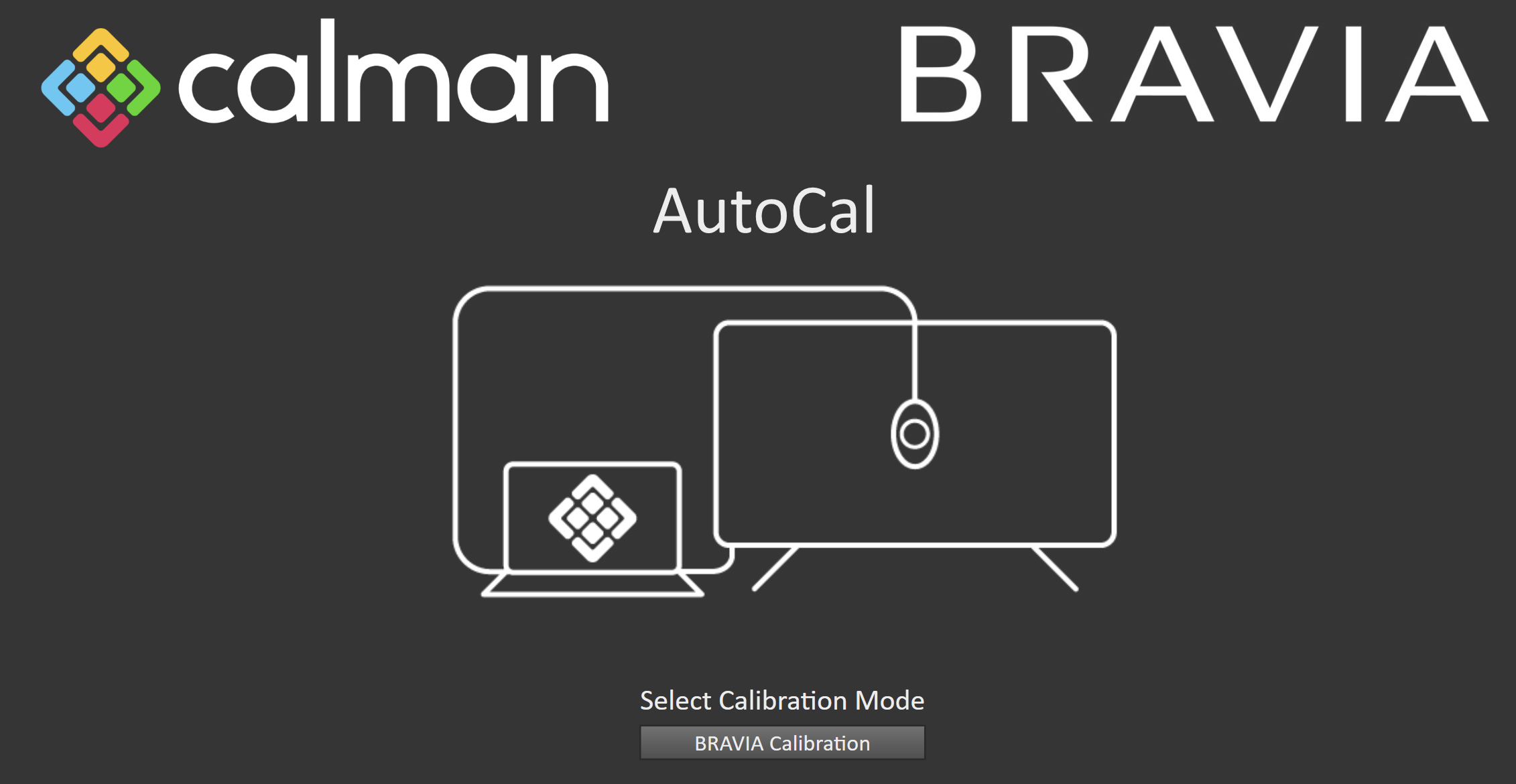
- From the Calman Menu in the top-left, choose Open Workflow Template -> Display Specific and then AutoCal – Sony BRAVIA
Step 2
Now, you will connect and configure your calibration hardware
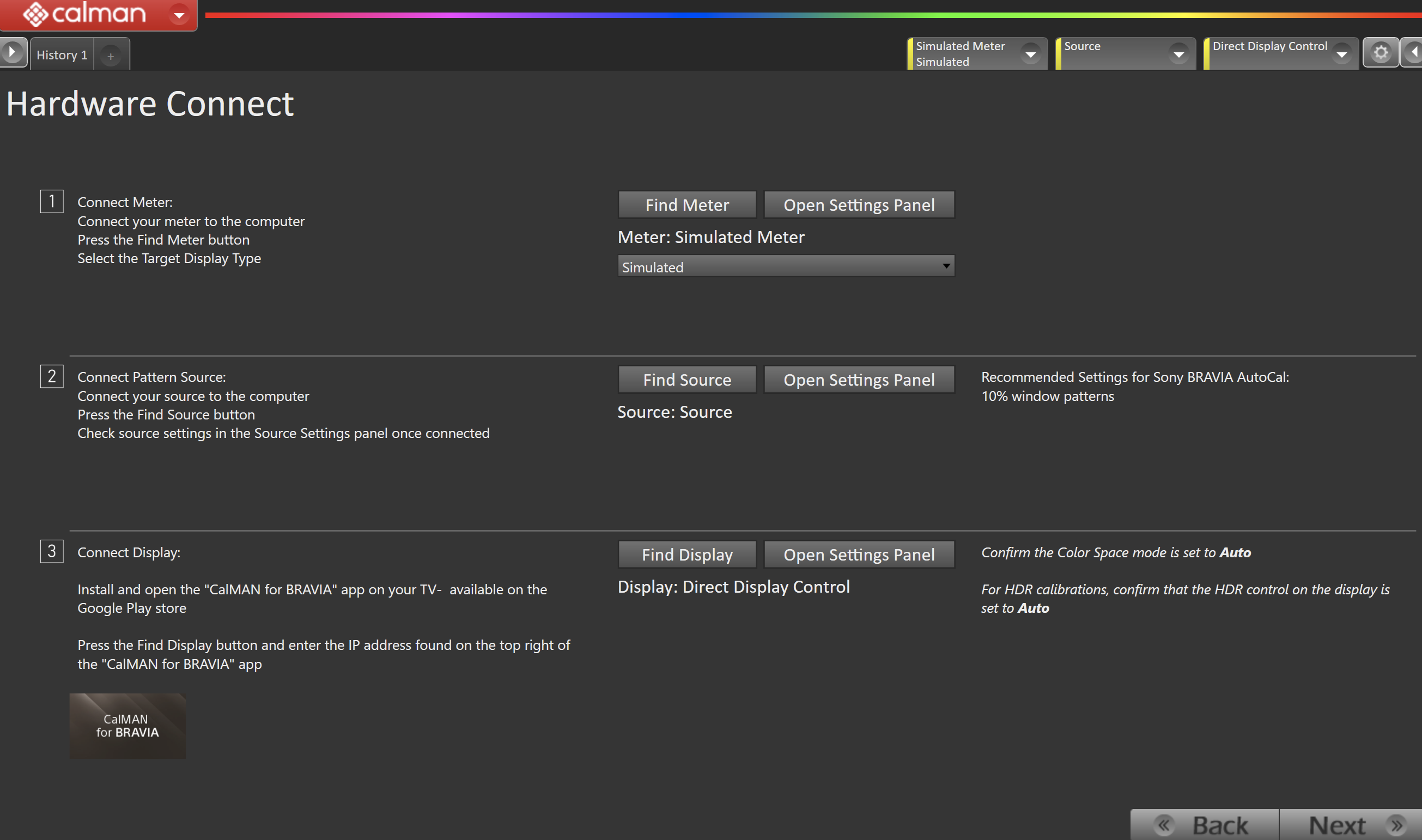
- Connect Your Meter
- Plug your meter into a USB port on the computer and press the Find Meter button on the left
- When your meter is connected, select your display type from the dropdown (this will vary by meter)
- OLED
- OLED models prior to 2023: White-OLED
- A95K: QD-OLED
- 2024 Bravia 8: White-OLED (Bravia 8 profile on C6 meters)
- 2024 Bravia 9: Mini-LED (Bravia 9 profile on C6 meters)
- LCD: Varies by model and year.
- OLED
- When your meter is connected, select your display type from the dropdown (this will vary by meter)
- Plug your meter into a USB port on the computer and press the Find Meter button on the left
- Connect Pattern Source to your computer
- Click the Find Source button then select your source
- Select the pattern window size
- OLED: Window 10%
- LCD: Constant APL 10
- Install the app
- Make sure your TV is connected to the Internet, then open Google Play Store on your TV.
- Search for and install an app called Calman for BRAVIA
- Note: If the app does not appear…
- Your TV may not be a compatible model
- Your TV may not be updated to Android 8.0
- Note: If the app does not appear…
Step 3
Confirm your calibration targets
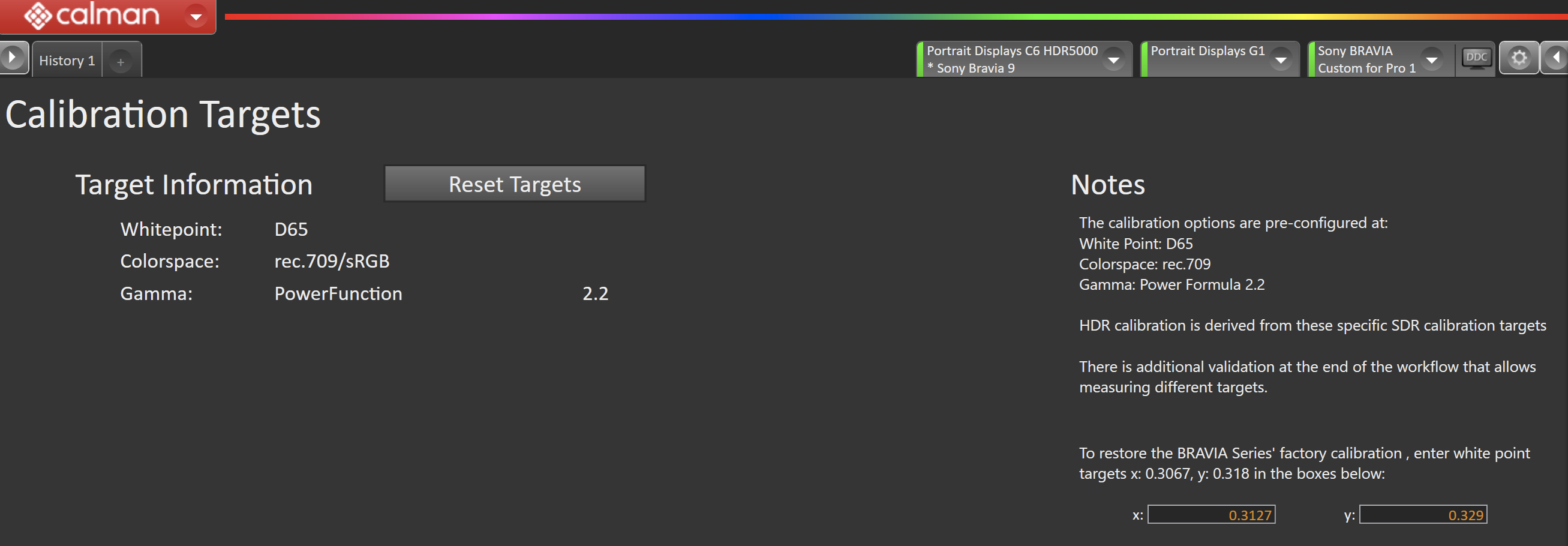
The calibration options are pre-configured at:
- Colorspace: BT.709
- White Point: D65
- Gamma: Power Formula 2.2
HDR calibration is derived from these specific SDR calibration targets. Additional validation at the end of the workflow allows for the measurement of different targets.
- To restore the Bravia’s factory calibration, enter white point targets x: 0.3067, y: 0.318
Step 4
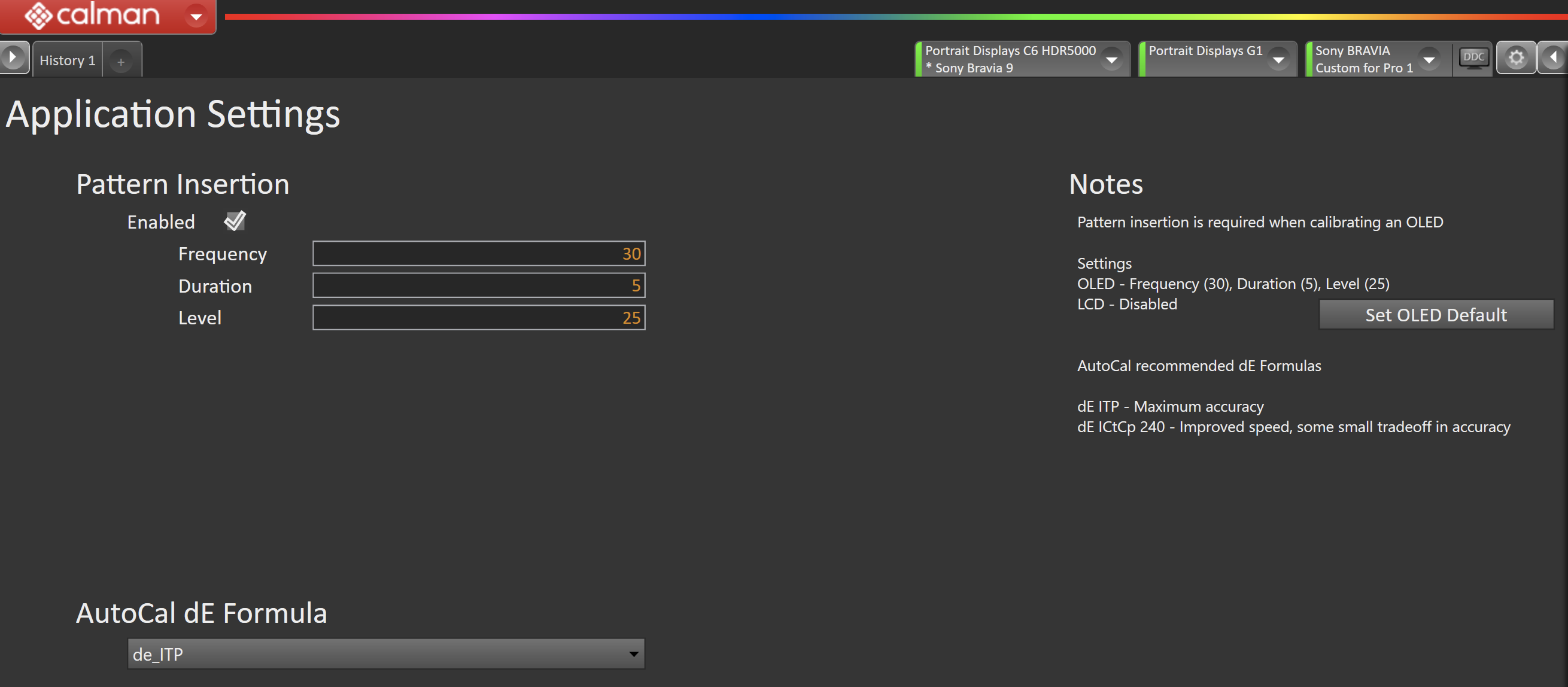
Full Field Pattern Insertion
To prevent an OLED display from entering its auto-dimming mode during extended measurements, the Calman Pattern Insertion feature periodically inserts a different test pattern during extended test pattern measurements, to reset the display’s auto-dimming timer. Brighter displays of other panel technology, like the Bravia 9, may also benefit from using these pattern insertion settings
-
Click the Set OLED Default to automatically configure and enable the best settings for OLED panels.
- Frequency: 30 (seconds)
- Duration: 5 (seconds)
- Level: 15%
Step 5
In this step, you’ll take readings of your display before the calibration. These will be used to compare your calibration results
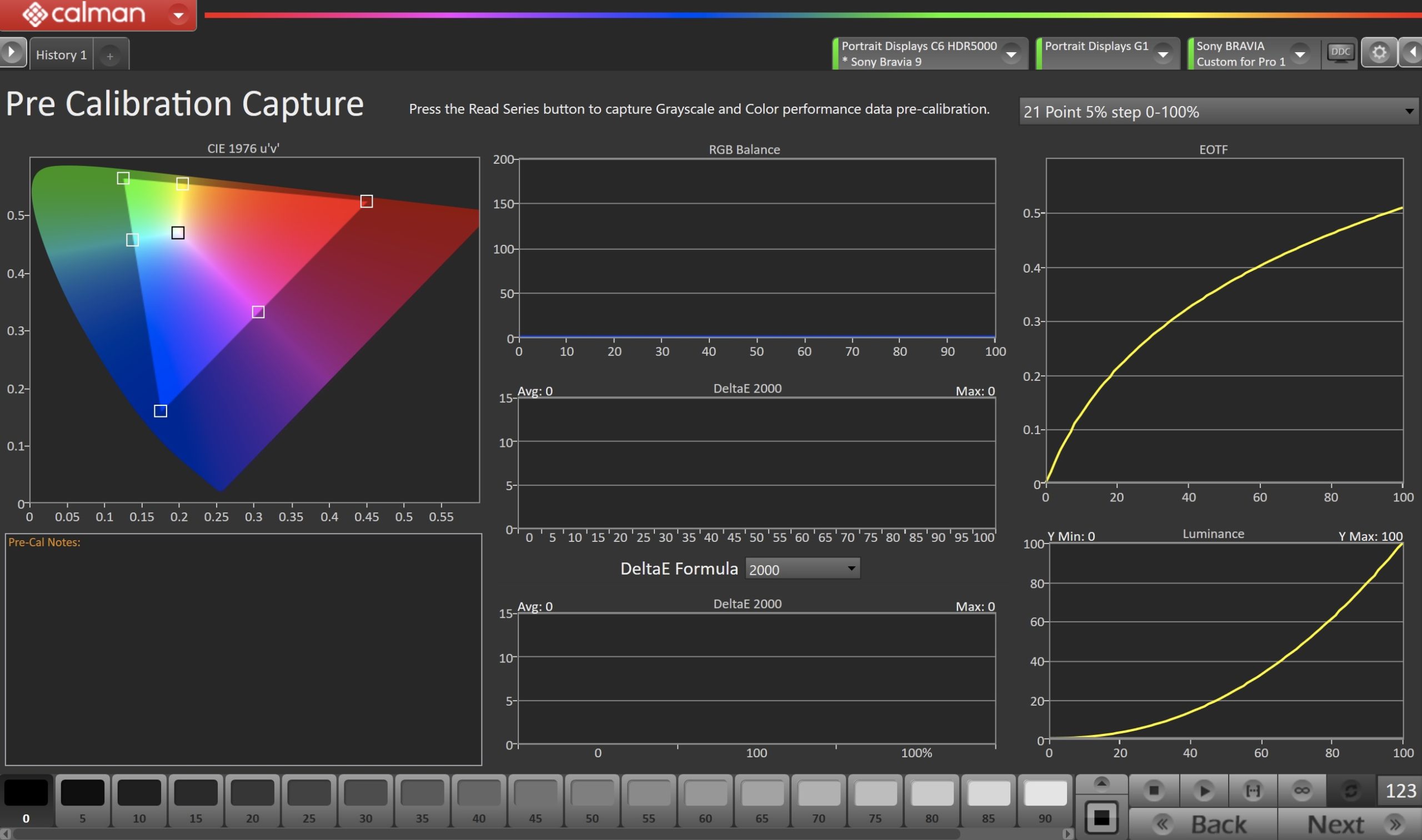
- To take Pre-Calibration Measurements click the Read Series […] button to measure the display’s grayscale and ColorChecker response
- This will provide a point of reference to compare your calibration results
Step 6
Select and prepare your Target Picture Mode
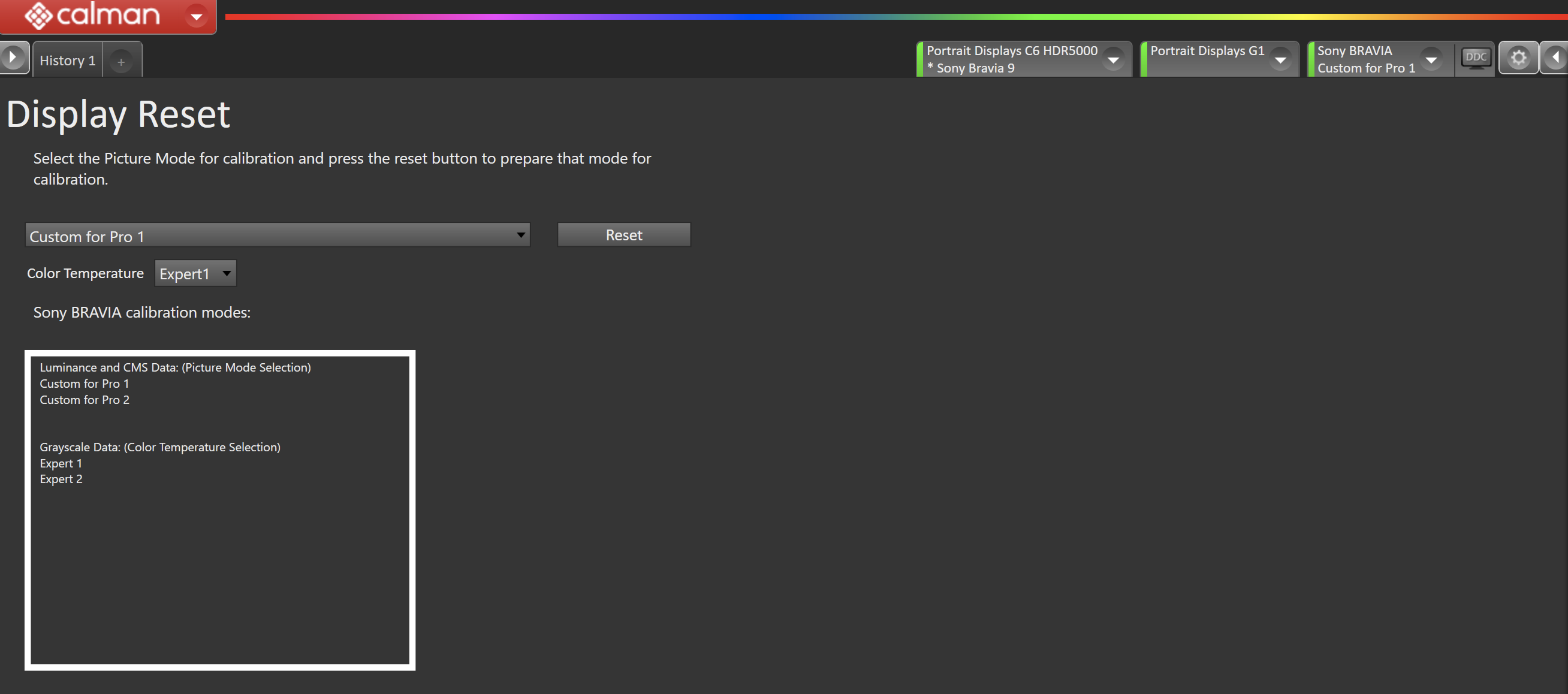
- Using the picture mode dropdown menu, or in the Display Control dropdown, select which picture mode you would like to calibrate.
- Also by using the color temperature dropdown menu, select where you would like to save the grayscale calibration.
- After selecting your picture mode, click the Full DDC Reset button. This resets and prepares the picture mode for calibration.
Note:
Sony TVs utilize a unique method of organizing and storing picture settings, which differs from most other manufacturers. This distinction is particularly important for professional calibration and achieving optimal picture quality.
- Picture Modes
- General settings like brightness and contrast are saved to the Picture Mode (e.g., Custom for Pro 1, Custom for Pro 2).
- Color Temperature
- Advanced settings, like CMS (Color Management System) and greyscale, are saved to the selected Color Temperature (e.g., Expert1, Expert2).
- Calibration Best Practices
- Use unique combinations of Picture Modes and Color Temperature for different targets (e.g., Custom for Pro 1 + Expert1 for one, and Custom for Pro 2 + Expert2 for another).
- Avoid overlap to prevent overwriting settings.
Step 7
In this step, you will be able to adjust the Luminance of your display to match your desired target.
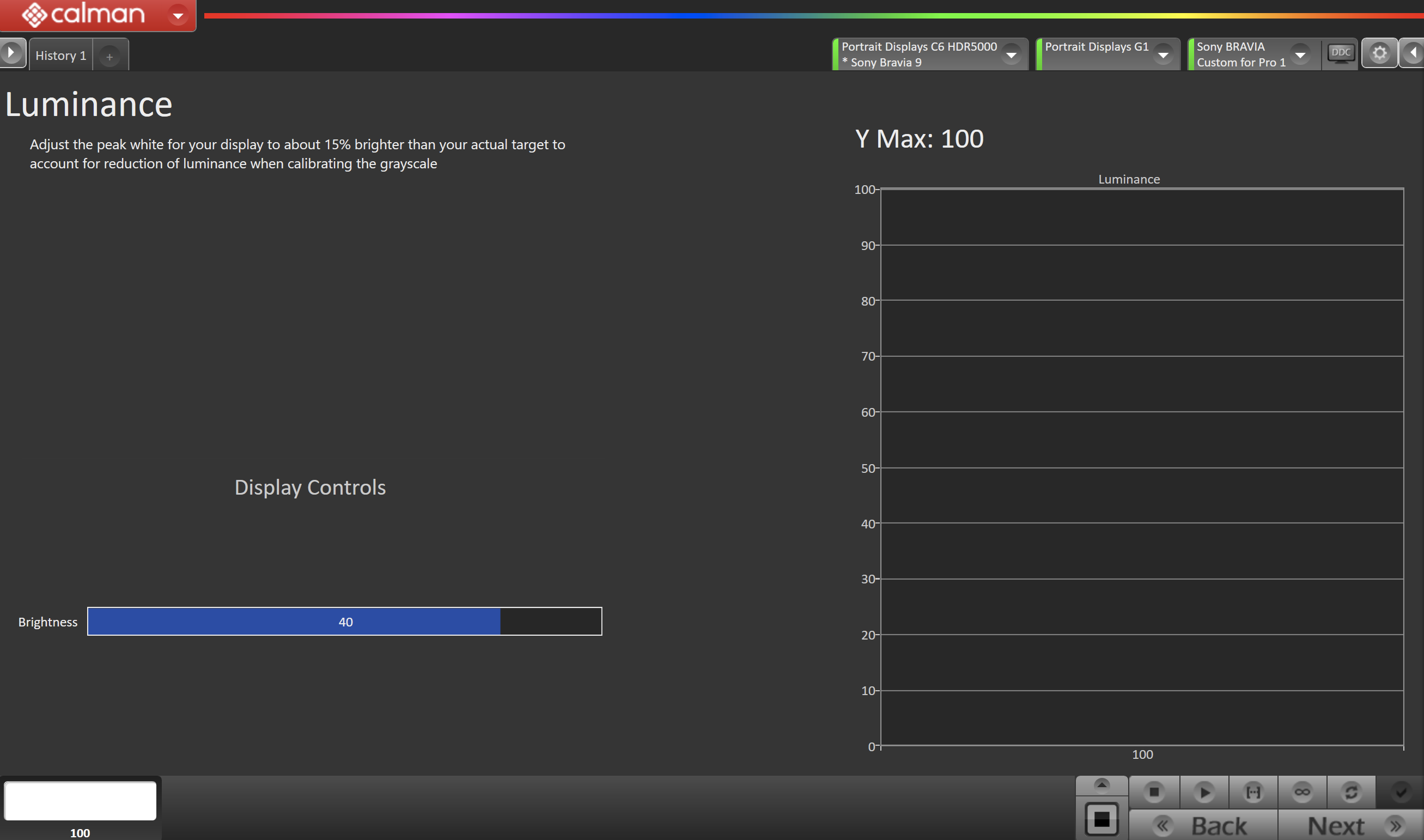
- Click the AutoCal Button
- Enter the target luminance value
- Click OK to AutoCal luminance
Step 8
Here Calman will adjust the Multipoint Greyscale of your display
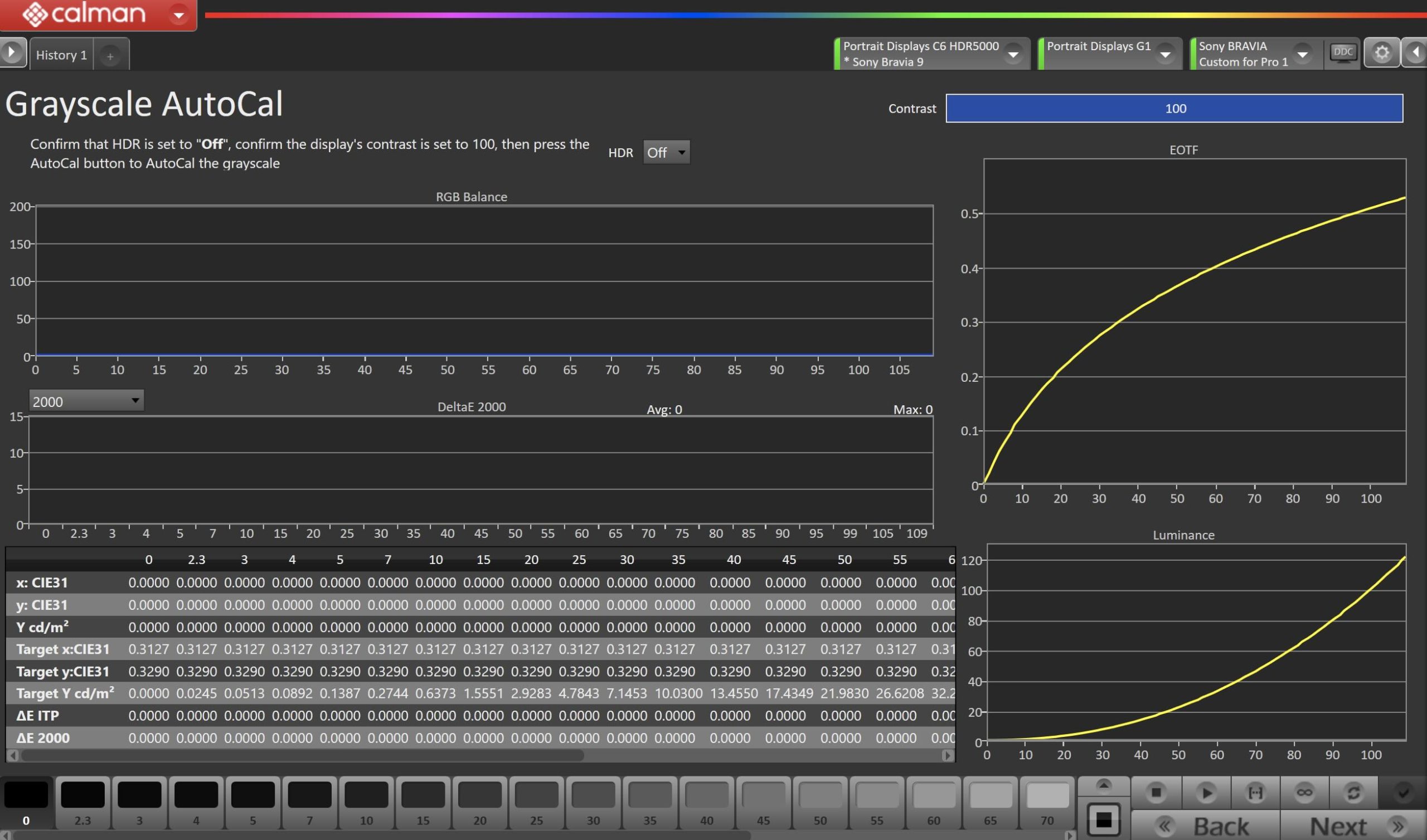
- Confirm that HDR is set to “Off”, and the display’s contrast is set to 100
- Press the AutoCal button and select the correct data points in the AutoCal Dialog to auto-calibrate the Grayscale/Luminance response on your display.
- You will be offered the correct number of greyscale points for your display
- Click OK to begin greyscale AutoCal
Step 9
Here Calman will adjust the Color Gamut of your display. This step will not be available on all displays
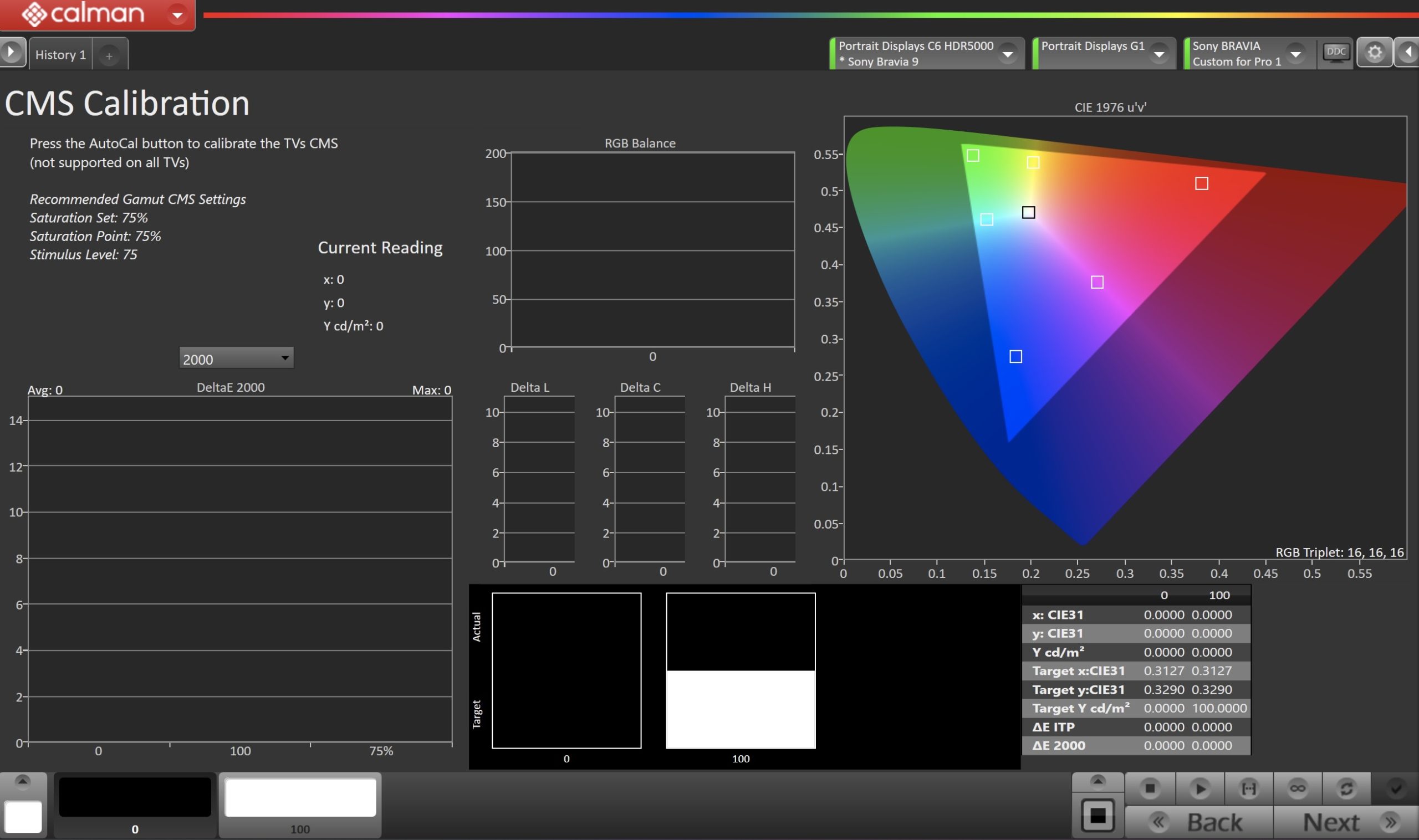
- Click AutoCal Button in lower-right of Calman
- In AutoCal Dialog, the CMS values are automatically selected, click OK to start AutoCal
- Note: If CMS on picture modes other than Custom for Pro 1/2 has to be adjusted, see the CMS calibration result on DDC Window (HSL values), and adjust exactly the same on the modes of your choice.
Step 10
In this step, you will be verifying the Luminance of your display after the calibration has been completed.
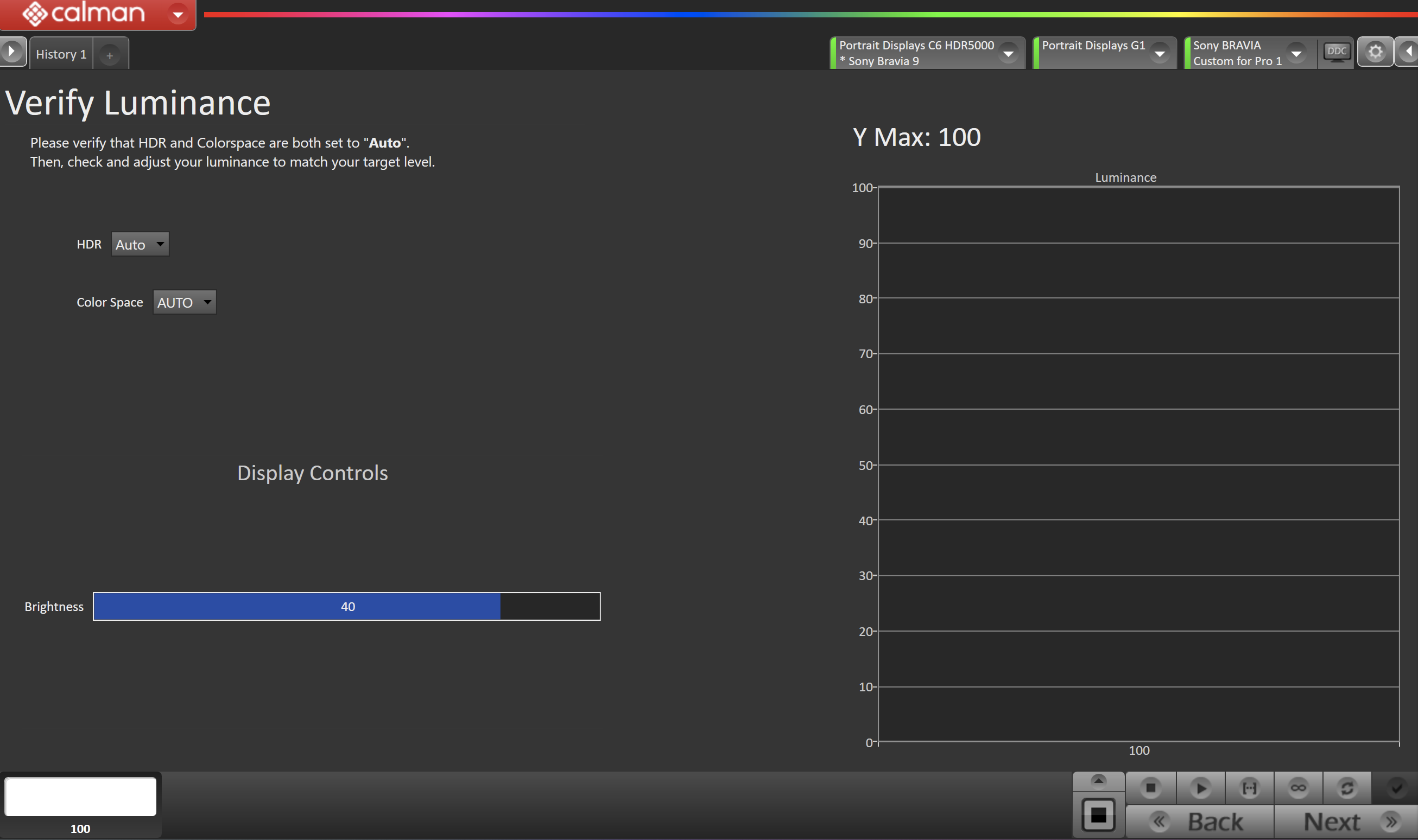
- Please verify that HDR and Colorspace are both set to “Auto”.
- Check and adjust your luminance to match your target level.
- Note: If CMS on picture modes other than Custom for Pro 1/2 has to be adjusted, see the CMS calibration result on DDC Window (HSL values), and adjust exactly the same on the modes of your choice.
Step 11
Post-calibration readings to document the post-calibration condition of the display.
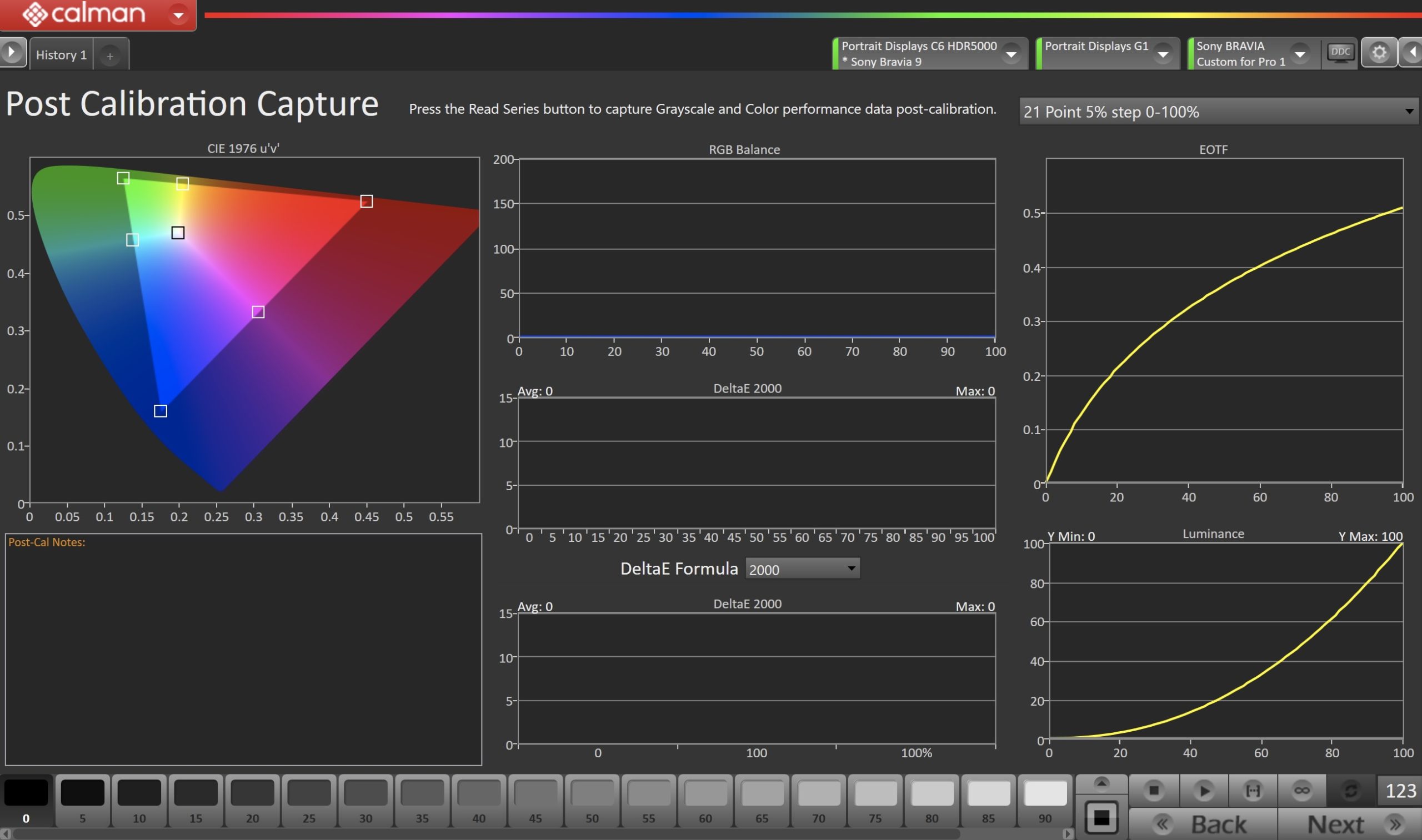
- Click the Read Series […] button
SDR Calibration is complete.
(OPTIONAL) Alternative Gamma Verification
This workflow is setup to calibrate to 2.2 gamma. If you would like to validate an alternate gamma value, enter it in the gamma field on the Verification Options page. Then use the “Display Controls” to the right to change the TV’s gamma formula to match the value you entered in the field above.
Note: Once an alternate gamma is selected use the post-calibration to verify the results. Previous workflow validation pages will compare to the adjusted gamma value.